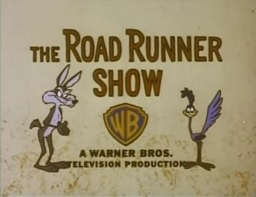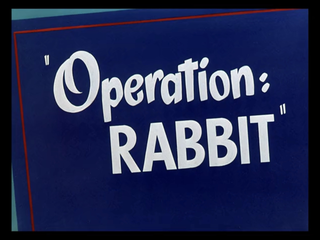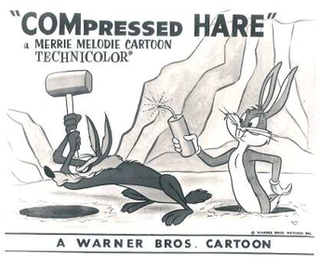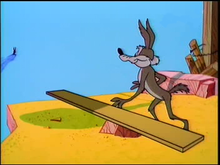
Looney Tunes is an American animated franchise produced and distributed by Warner Bros. It began as a series of short films that originally ran from 1930 to 1969, concurrently with its partner series Merrie Melodies, during the golden age of American animation. Following a revival in the late 1970s, new shorts were released as recently as 2014. The two series introduced a large cast of characters, including Bugs Bunny, Daffy Duck, and Porky Pig. The term Looney Tunes has since been expanded to also refer to the characters themselves.

Wile E. Coyote and the Road Runner are a duo of cartoon characters from the Looney Tunes and Merrie Melodies series of animated cartoons, first appearing in 1949 in the theatrical cartoon short Fast and Furry-ous. In each episode, the cunning, devious and constantly hungry coyote repeatedly attempts to catch and subsequently eat the Road Runner, but is always humorously unsuccessful in doing so. Instead of his animal instincts, the coyote uses absurdly complex contraptions to try to catch his prey. They comically backfire, with the coyote often getting injured in slapstick fashion. Many of the items for these contrivances are mail-ordered from a variety of companies implied to be part of the Acme Corporation.

Fast and Furry-ous is a 1949 Warner Bros. Looney Tunes cartoon, directed by Chuck Jones and written by Michael Maltese. The short was released on September 17, 1949, and stars Wile E. Coyote and the Road Runner, in their debut.
Paul Hull Julian was an American background animator, sound effects artist and voice actor for Warner Bros. Cartoons. He worked on Looney Tunes short films, primarily on director Friz Freleng's Sylvester and Tweety Bird shorts.

The Bugs Bunny/Road Runner Movie is a 1979 American animated comedy package film directed by Chuck Jones, consisting of a compilation of classic Looney Tunes/Merrie Melodies shorts and newly animated bridging sequences hosted by Bugs Bunny. The bridging sequences, which had been produced in 1978, show Bugs at his home, which is cantilevered over a carrot-juice waterfall. The film was released to celebrate the 40th anniversary of Bugs Bunny.

The Road Runner Show is an American Saturday morning animated anthology series which compiled theatrical Wile E. Coyote and the Road Runner cartoons from the Looney Tunes and Merrie Melodies, which were produced by Warner Bros. Cartoons between 1949 and 1964. Several of the shorts, especially the ones produced from 1965 onward, were produced by DePatie–Freleng Enterprises after Warner Bros. closed their animation studio. DePatie–Freleng Enterprises provided the animation for the show's intro, closing credits as well as the wrap-around bumpers.

Operation: Rabbit is a 1952 Warner Bros. Looney Tunes animated cartoon directed by Chuck Jones. The cartoon was released on January 19, 1952, and features Bugs Bunny and Wile E. Coyote. This marks the second appearance of Wile E. Coyote, the first where he is named, and the first where he has spoken dialogue.

Kids' WB Fun Zone is a themed attraction in Warner Bros. Movie World on the Gold Coast, Queensland, Australia based on the Looney Tunes cartoons. The attraction was originally named Looney Tunes Village and was renamed in late 2007 when two new rides were added. At the same time, the Australian Kids' WB TV show began filming at the theme park. Two similar themed attractions, Looney Tunes Land and Cartoon Village, opened at Warner Bros. Movie World Germany in Bottrop Kirchhellen, Germany in 1996 and Parque Warner Madrid in Madrid, Spain in 2002, respectively, with the latter remaining to this day.

Guided Muscle is a 1955 Warner Bros. Looney Tunes cartoon directed by Chuck Jones. The short was released on December 10, 1955, and stars Wile E. Coyote and the Road Runner.
Hip Hip-Hurry! is a 1958 Warner Bros. Merrie Melodies cartoon directed by Chuck Jones. The short was released on December 6, 1958, and stars Wile E. Coyote and the Road Runner. The title is a pun on the phrase "Hip Hip Hooray!!"

To Hare is Human is a 1956 Warner Bros. Merrie Melodies cartoon directed by Chuck Jones. The short was released on December 15, 1956, and stars Bugs Bunny and Wile E. Coyote. In this film, Wile builds a UNIVAC computer, and grows to rely on its answers.

Portrait of the Artist as a Young Bunny is a Warner Bros. cartoon starring Bugs Bunny and Elmer Fudd, with cameo appearances by Wile E. Coyote and the Road Runner. The cartoon was part of the television special Bugs Bunny's Bustin' Out All Over, which aired May 21, 1980. The title is a reference to A Portrait of the Artist as a Young Man by Irish novelist James Joyce.

Compressed Hare is a 1961 Merrie Melodies cartoon directed by Chuck Jones and Maurice Noble. The short was released on July 29, 1961, and stars Bugs Bunny and Wile E. Coyote. This is the final first-run Golden Age short in which Wile E. Coyote speaks, although he speaks again in the Adventures of the Road Runner featurette a year later.
Quick Brown Fox and Rapid Rabbit were a pair of Warner Bros. cartoon characters, created by Robert McKimson, who appeared in only one cartoon, Rabbit Stew and Rabbits Too! Future cartoons featuring the characters were planned, but were cancelled following the shutdown of Warner Bros.-Seven Arts Animation on October 10, 1969.

Rabbit's Feat is an animated 1960 Warner Bros. Looney Tunes cartoon, directed by Chuck Jones and written by Michael Maltese. The short was released on June 4, 1960, and stars Bugs Bunny and Wile E. Coyote. As Maltese had left for Hanna-Barbera, his name was removed from the credits.
Looney Tunes Super Stars is a series of nine Looney Tunes DVDs consisting of two Bugs Bunny DVDs and other characters who got their own collections. It started on August 10, 2010 and ran until April 23, 2013. The series consists of:

The Looney Tunes Show is an American animated sitcom produced by Warner Bros. Animation, and aired on Cartoon Network for two seasons from May 3, 2011, to November 2, 2013. The series differed from others featuring characters from the Looney Tunes, by focusing on stories conformed around a sitcom format involving the characters of Bugs Bunny and Daffy Duck, who live a surburban life together within a neighborhood of fellow cartoon neighbors, dealing with various issues in their own way. Both the characters from the Looney Tunes, as well as the Merrie Melodies theatrical cartoon shorts, were given a 21st century update, with episodes also including a musical short; the first series also included computer-animated shorts involving new antics between Wile E. Coyote and the Road Runner.
Clippety Clobbered is a 1966 Warner Bros. Looney Tunes theatrical animated short directed by Rudy Larriva. The short was released on March 12, 1966, and stars Wile E. Coyote and the Road Runner.













